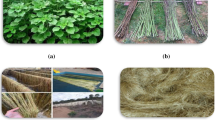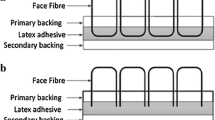Abstract
Fiber-reinforced concrete has widely been used due to its advantage that it excels over plain concrete. The present study highlights the metallic and non-metallic fiber effect in varying percentages on waste ceramic optimal concrete (WOC) mechanical behavior. WOC has been obtained by replacing plain M25 grade concrete constituent with ceramic constituent (20% ceramic aggregate, 10% ceramic sand, and 10% ceramic powder) on the basis of compressive, tensile, flexural, and combined (flexure and torsion) strength test performed in the laboratory. Two types of metallic fibers, namely hooked-end steel fiber (HK) and crimped steel fiber (CR), and two types of non-metallic fibers, namely polyvinyl alcohol fiber (PVA) and polypropylene fiber (PP), have been used. Based on the total concrete volume, two fiber fractions of 1% and 2% were added to the specimen. Overall, 108 samples were cast for testing in compression on cube, tension on cylinder, flexure on beam, and combined (flexure and torsion) on the beam. For each test and each percentage, three samples were cast. Encouraging results have been obtained for both metallic and non-metallic fibers. In metallic fiber-WOC, optimal increment with respect to plain WOC in compression, tension, flexure, and combined (flexure and torsion) has been found 3.64%, 85.56%, 92.59%, and 85.18%, respectively, for 2% CR fiber wherein, for non-metallic case, the increment was obtained as 5.52%, 30.59%, 9.62%, and 9.09%, respectively, for 1% PVA fiber.
















Similar content being viewed by others
References
Mohammed H, Ahmed S (2020) Mechanical performance evaluation of concrete with waste coarse ceramic aggregate. Smart cities—opportunities and challenges. Springer, Singapore, pp 593–605
Seitl S, Viszlay V, Domski J, Katzer J (2017) Fracture mechanical properties of cement based composites with various amount of waste aggregates. Procedia Eng 190:345–351. https://doi.org/10.1016/j.proeng.2017.05.347
Brandt AM (2008) Fibre reinforced cement-based (FRC) composites after over 40 years of development in building and civil engineering. Compos Struct 86(1–3):3–9. https://doi.org/10.1016/j.compstruct.2008.03.006
Yoo DY, Yoon YS, Banthia N (2015) Predicting the post-cracking behavior of normal-and high-strength steel-fiber-reinforced concrete beams. Constr Build Mater 93:477–485. https://doi.org/10.1016/j.conbuildmat.2015.06.006
Banthia N, Gupta R (2004) Hybrid fiber reinforced concrete (HyFRC): fiber synergy in high strength matrices. Mater Struct 37(10):707–716. https://doi.org/10.1007/BF02480516
Wu Z, Shi C, Khayat KH (2019) Investigation of mechanical properties and shrinkage of ultra-high performance concrete: influence of steel fiber content and shape. Compos B Eng 174:107021. https://doi.org/10.1016/j.compositesb.2019.107021
Bolat H, Şimşek O, Çullu M, Durmuş G, Can Ö (2014) The effects of macro synthetic fiber reinforcement use on physical and mechanical properties of concrete. Compos B Eng 61:191–198. https://doi.org/10.1016/j.compositesb.2014.01.043
Hannawi K, Bian H, Prince-Agbodjan W, Raghavan B (2016) Effect of different types of fibers on the microstructure and the mechanical behavior of ultra-high performance fiber-reinforced concretes. Compos B Eng 86:214–220. https://doi.org/10.1016/j.compositesb.2015.09.059
Cavalaro SHP, López R, Torrents JM, Aguado A (2015) Improved assessment of fibre content and orientation with inductive method in SFRC. Mater Struct 48(6):1859–1873. https://doi.org/10.1617/s11527-014-0279-6
Atiş CD, Karahan O (2009) Properties of steel fiber reinforced fly ash concrete. Constr Build Mater 23(1):392–399. https://doi.org/10.1016/j.conbuildmat.2007.11.002
KM AF, Varghese S (2014) Behavioural study of steel fiber and polypropylene fiber reinforced concrete. Int J Res Eng Technol 2(10):17–24
Mohammadi Y, Kaushik SK (2005) Flexural fatigue-life distributions of plain and fibrous concrete at various stress levels. J Mater Civ Eng 17(6):650–658. https://doi.org/10.1061/(ASCE)0899-1561(2005)17:6(650)
Noushini A, Samali B, Vessalas K (2013) Effect of polyvinyl alcohol (PVA) fibre on dynamic and material properties of fibre reinforced concrete. Constr Build Mater 49:374–383. https://doi.org/10.1016/j.conbuildmat.2013.08.035
Atahan HN, Pekmezci BY, Tuncel EY (2013) Behavior of PVA fiber-reinforced cementitious composites under static and impact flexural effects. J Mater Civ Eng 25(10):1438–1445. https://doi.org/10.1061/(ASCE)MT.1943-5533.0000691
Hasan A, Maroof N, Ibrahim Y (2019) Effects of polypropylene fiber content on strength and workability properties of concrete. Polytech J 9(1):7–12
Ling Y, Zhang P, Wang J, Chen Y (2019) Effect of PVA fiber on mechanical properties of cementitious composite with and without nano-SiO2. Constr Build Mater 229:117068. https://doi.org/10.1016/j.conbuildmat.2019.117068
Ahmed S, Bukhari IA, Siddiqui JI, Qureshi SA (2006) A study on properties of polypropylene fiber reinforced concrete. In: 31st conference on our world in concrete and structures, pp 63–72
Salih SA, Al-Azaawee ME (2008) Effect of polypropylene fibers on properties of mortar containing crushed bricks as aggregate. Eng Technol 26(12):1508–1513
IS 516 (1959) Methods of tests for strength of concrete. Bureau of Indian Standards, New Delhi
IS 10262 (2009) Indian standard concrete mix proportioning—guidelines. Bureau of Indian Standards, New Delhi, p 110002
IS 12269 (2013) Indian standard ordinary portland cement, 53 grade specification. Bureau of Indian Standards, New Delhi, p 110002
IS 383 (1970) Indian standard specification for coarse and fine aggregates from natural sources for concrete. Bureau of Indian Standards, New Delhi, p 110002
IS 10262 (2009) Indian standard concrete mix proportioning—guidelines. Bureau of Indian Standards, New Delhi, p 110002
Funding
No funding was received for conducting this study.
Author information
Authors and Affiliations
Corresponding author
Ethics declarations
Conflict of interest
All authors certify that they have no affiliations with or involvement in any organization or entity with any financial interest or non-financial interest in the subject matter or materials discussed in this manuscript.
Rights and permissions
About this article
Cite this article
Najm, H.M., Ahmad, S. The effect of metallic and non-metallic fiber on the mechanical properties of waste ceramic concrete. Innov. Infrastruct. Solut. 6, 204 (2021). https://doi.org/10.1007/s41062-021-00571-4
Received:
Accepted:
Published:
DOI: https://doi.org/10.1007/s41062-021-00571-4




